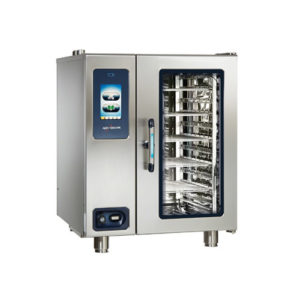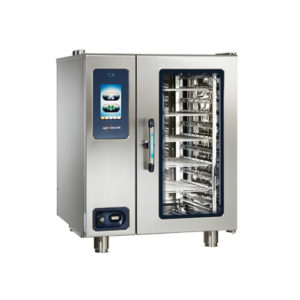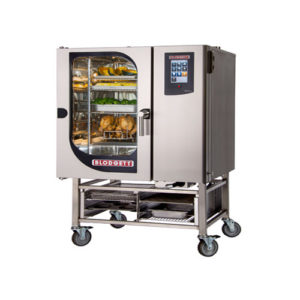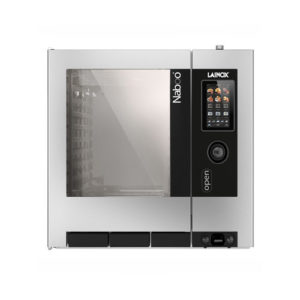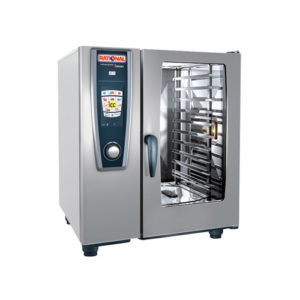15 Jul, 2018
Buying Guide | Commercial Combi Oven
A Combination Oven (or combi steamer) is a highly advanced machine which cooks food using steam, convection or a combination of both. These powerful appliances are often among the largest and most expensive pieces of equipment in the professional kitchen, so it’s important to choose the one that best meets your kitchen needs. Since Commercial Combi Ovens are available as floor models, countertop models, and double-stacked models, knowing the amount of space you have and the cooking chamber capacity you need will help significantly narrow down your potential options. Ovens specify how many and what size pans their chambers can hold. While some smaller combi ovens only hold 5 half-size pans, larger models have room for as many as 40 half-size pans.
This guide explains the main features and terminology seen in combination ovens, as well as some of the considerations you should have in mind before purchase.
What Are Combi Ovens Used For?
Combi ovens really are amongst the most versatile machines used by chefs. These powerful machines can roast, poach, steam, grill, bake, shallow fry and even sous vide or smoke food.
Breakfast
is easy in a combi. You can quickly cook large quantities of bacon, sausage, eggs, mushrooms and tomatoes, all at the same time – mostly with the touch of a single button. Croissants and delicate pastries can be cooked to perfection too. Some advanced combis will provide all the timings, making one less thing to worry about.
Lunch
service is equally simple. Whether you’re baking jacket potatoes, roasting a joint of beef or grilling steaks, a combination oven can produce deliciously tender results, with a much higher yield* in comparison to conventional ovens and ranges. Combination ovens can also be used to hot hold meats for extended periods, meaning you’ve always got the next joint ready for carving.
Dinner
is covered by a combi too. Delicate fish can be poached or steamed to keep all its flavour and nutrients, whilst vegetables are steamed carefully to keep their crispiness and fresh taste.
How Does A Combi Oven Work ?
At its basic level, combination ovens are rather simple. A fan (or multiple fans) are used to distribute dry heat evenly throughout the cabinet – very much the same as a standard convection oven.
If needed, the oven will then inject water or steam into the oven which quickly raises the humidity to the required level. The combination of heat and steam helps to seal in flavours, improve yield and cook faster.
Combi ovens can also remove moisture from food. By venting humidity (releasing steam), food is cooked faster and crisps perfectly – ideal for bacon or pork crackling.
What You Need To Know!
The right combination oven can save you vast amounts of time, energy, space and money. However, buying the wrong one could prove costly, so it’s vital to be in the know before you buy. Here is a brief checklist of the most important considerations.
Size/Space
Combi ovens range in size from compact 2/3rd gastronorm compatible versions which can be built in, all the way up to huge roll-in models which can hold around 40 full size GN pans. Some models can also accommodate full-size bakery trays as well. Although a larger oven means a higher capacity, it also means it might not fit in your kitchen. Check dimensions before purchase
Power Supply
Options available are usually LPG or natural “mains” gas, as well as single or three phase electricity. There’s not a huge difference in performance between electric combi oven and gas combi oven, although three phase versions tend to be more popular than single phase ovens. The decision is usually determined by your existing kitchen power supply. Remember that even gas combi ovens usually also require an electricity connection
Control
Ideally, the easier the better. Control on combi ovens falls broadly under the Manual or Programmable bracket, although even manual ovens have the option to pre-set the various cooking modes. Generally, manual models have buttons and dials, whereas modern programmable ovens have large tablet-style touchscreen panels.Some chefs may prefer the hands-on feel of manual control. However, programmable versions make it much easier for inexperienced cooks to produce good results.
Extraction
Combi ovens can produce a lot of steam and heat, so it’s vital to have sufficient overhead extraction. In most cases, extraction is a legal requirement. Some advanced combination ovens may have the option for built-in extraction at an additional cost.
Water Softener
Almost all combi ovens require a permanent water connection to provide adequate steam during the cooking process. As mains water can contain limescale and other contaminants, a commercial water softener is usually recommended simply to prevent build-up inside the machine.
Which Combi Oven Is Best?
On the outside many combi ovens look very similar, so it’s hard to tell on first glance which one would be most suitable. However, the best combi is the one which meets all the demands of your kitchen. Whilst the latest models feature some of the most advanced technology in the kitchen, you may not need all that functionality. Likewise, if you have many kitchens spread across the country, the additional investment may pay for itself quickly in terms of staff training and oven output. Whether you invest or not, it’s important to know what you’re buying, so here are some other features and accessories you should consider before purchase.
Cleaning
Most modern combination ovens have a self-cleaning cycle which leaves the unit sparkling clean after use. However, each manufacturer has developed their own methods of cleaning, alongside different types of cleaning chemicals. For example, Rational use detergent tabs, which look quite similar to household dishwasher versions (although commercial tabs are far more powerful). Others commonly use pre-mixed chemical, which is added to a container attached to the oven. When handling any combi oven cleaning chemical, it’s strongly recommended to wear suitable PPE.
Temperature Probe
Almost all combis have either a detachable or fixed temperature probe. When inserted into food, the probe provides constant feedback on the cooking progress, so some ovens will adjust temperatures and cooking times according to the results. This means you can start the cook and let the oven do the rest. Probes can also record temperatures for HACCP compliance. Note that temperature probes have “points”. This refers to the number of parts of the probe that temperature is recorded. Generally, the more points, the more accurately the oven can cook as more of the food is monitored. Some premium ovens will allow multiple probes to be used simultaneously.
Hand Shower
A hand shower brings much-needed convenience. Usually simply just clipped to the side of the oven, the shower is designed to help quickly fill pots and rinse food debris away from the oven floor to make cleaning easier. Note that it’s not supposed to be used for cleaning the hot interior panels of the oven – the cleaning routine will almost always leave the oven absolutely spotless.
Stand
Although the largest combi ovens are freestanding, some of the smaller versions will require a base. This can either be a dedicated stand with shelves or a Love Fridge depending on your requirements. Either way, if the fridge or stand has castors, the oven can be positioned for easy cleaning.
Connectivity
Modern combi ovens give you the option of saving your cooking routines and HACCP data onto a USB stick or even to the cloud via Wi-Fi. This is particularly useful in multi-site chains, as you can ensure new menu items are all cooked the same, even across potentially hundreds of different buildings.
Things to Consider:
Price
Electric models are typically less expensive than gas fueled Combi ovens.
Efficiency
Gas models offer a faster rate at which it can reach a desired temperature because the energy transfer is direct and therefore increases the temperature instantly.
Cost of Utility
When choosing the right utility for your new Combi oven you should also consider the prices of utility for each around your location.
Availability
The level of availability for both gas and electric.
Common Commercial Combi Oven
|
|
|
|
|
|
|

